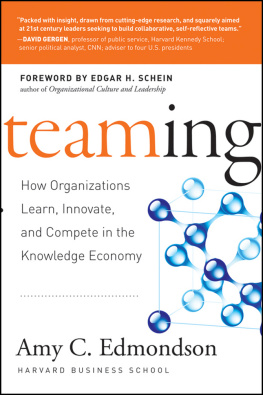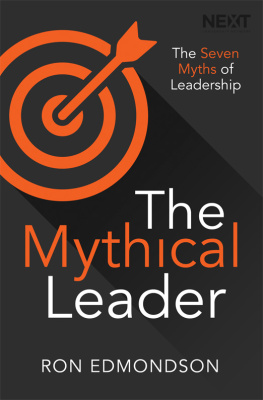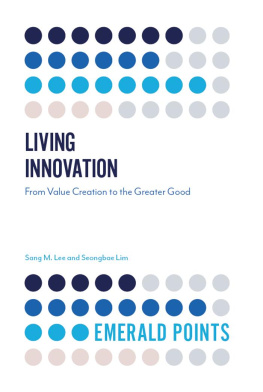More Praise for Building the Future
City building may be the most important challenge of the 21st century, and it is a challenge that needs entrepreneurial brilliance as much as engineering. Edmondson and Reynolds provide an engaging glimpse at innovatorssuch as Living PlanIT and Quintainwho are changing our urban world. This thoughtful book is full of managerial wisdom and urban insight.
Edward Glaeser, Glimp Professor of Economics, Harvard University, and author of Triumph of the City
Building the Future is a remarkable book. It introduces readers to the cross-industry teaming thats needed to build the cities of tomorrow and offers an urgent reminder that technology alone cant solve global problemscooperation, ingenuity, and empathy are needed to innovate on a grand stage. A must-read for anyone interested in the future of business or the future of the planet.
Douglas Stone, Lecturer on Law, Harvard Law School, and coauthor of Difficult Conversations and Thanks for the Feedback
Every start-up wants to change the world and disrupt an industry or two along the way. But what happens when you dont? Edmondson and Reynolds glean important lessons from the story of one such company grappling with the biggest challenge of our time: building more sustainable cities. Their inside account of setbacks and brushes with failure has more to teach us than any just-so stories of success.
Greg Lindsay, coauthor of Aerotropolis and Senior Fellow, New Cities Foundation
What we witness in this thoughtful and compelling study is one of the heroic battles that are being enacted across the globe as visionary, fleet-footed technology start-ups collide with big business and the politics of government. As the urbanization of the planet gathers pace and governments grapple with the fateful consequences, can technology support a better future for our cities? Building the Future follows a small start-up business that believes it can and examines the leadership demands of ambition on this scale.
Andrew Comer, Partner and Director of the Cities Group, BuroHappold Engineering
Get ready. What you are about to read is unlike anything youve read before on innovation, teams, the built environment, or even leadership. Edmondson and Reynoldsa world-class academic and journalisthave joined forces to explore, document, and understand how complex innovation actually unfolds and the leadership required for its success. Based on multiyear observations of an entrepreneurial effort to build a smart, green city, Building the Future brings the challenges of the future into the present so we can see what it will take to create a world that works for all of us.
Diana McLain Smith, author of The Elephant in the Room
Building the
FUTURE
Other Books by Amy C. Edmondson:
A Fuller Explanation: The Synergetic Geometry of R. Buckminster Fuller
Teaming: How Organizations Learn, Innovate, and Compete in the Knowledge Economy
Teaming to Innovate
Building the
FUTURE
Big Teaming for Audacious Innovation
Amy C. Edmondson
Susan Salter Reynolds

Building the Future
Copyright 2016 by Amy C. Edmondson and Susan Salter Reynolds
All rights reserved. No part of this publication may be reproduced, distributed, or transmitted in any form or by any means, including photocopying, recording, or other electronic or mechanical methods, without the prior written permission of the publisher, except in the case of brief quotations embodied in critical reviews and certain other noncommercial uses permitted by copyright law. For permission requests, write to the publisher, addressed Attention: Permissions Coordinator, at the address below.
|
|---|

| Berrett-Koehler Publishers, Inc.
1333 Broadway, Suite 1000
Oakland, CA 94612-1921
Tel: (510) 817-2277, Fax: (510) 817-2278
www.bkconnection.com |
Ordering information for print editions
Quantity sales. Special discounts are available on quantity purchases by corporations, associations, and others. For details, contact the Special Sales Department at the Berrett-Koehler address above.
Individual sales. Berrett-Koehler publications are available through most bookstores. They can also be ordered directly from Berrett-Koehler: Tel: (800) 929-2929; Fax: (802) 864-7626; www.bkconnection.com
Orders for college textbook/course adoption use. Please contact Berrett-Koehler: Tel: (800) 929-2929; Fax: (802) 864-7626.
Orders by U.S. trade bookstores and wholesalers. Please contact Ingram Publisher Services, Tel: (800) 509-4887; Fax: (800) 838-1149; E-mail: /Ordering for details about electronic ordering.
Berrett-Koehler and the BK logo are registered trademarks of Berrett-Koehler Publishers, Inc.
First Edition
Hardcover print edition ISBN 978-1-62656-419-0
PDF e-book ISBN 978-1-62656-420-6
IDPF e-book ISBN 978-1-62656-421-3
2016-1
Cover design by Kirk DouPonce, DogEared Design. Cover illustration by
iStock/Hakkiarslan. Interior design and composition by Gary Palmatier, Ideas to Images.
Elizabeth von Radics, copyeditor; Mike Mollett, proofreader; Rachel Rice, indexer.
To future-builders everywhere
Contents
Preface
C URIOUS ABOUT INNOVATION IN THE BUILT ENVIRONMENT, WE JUMPED at the chance to study a startup with the audacious goal of transforming the urban landscape with technology. Wherever you work, the demand for innovation is likely intense. After all, developing great new products that delight customers is a surefire way to win in a competitive marketplace. But this book tackles a different kind of innovation challengethe kind that involves introducing not a new product but an entire new system.
Consider two history-shaping innovations found in the kitchen of most modern households. One, the refrigerator, transformed how we eat by enabling the preservation of perishable foods for days and even weeks. The other, the telephone, a smaller object with far greater physical reach, puts us in instant contact with distant friends and colleagues. Today both are taken-for-granted household objects.
A crucial difference between these familiar innovations is that one is a stand-alone product and the other functions as part of a complex system. That difference motivates this book. The refrigerator can be purchased, delivered, and usedlike hundreds of other products we might find in the home. The telephone, in contrast, does little on its own. To have practical use, an entire system of components, wires, poles, regulations, services, and customers had to be developed around it, involving players from multiple industry sectors. Putting Alexander Graham Bells 1876 patent for a device to transmit the human voice through an electric current into world-changing use required, in short, the cooperative action of technologists, service personnel, government regulators, real estate owners, designers, builders, electricians, lumber companies, operators, and more. When the first telephone exchangewith 21 subscriberswas built in 1877 in New Haven, Connecticut, a few of these players had come together to present a first, small-scale demonstration of a telecommunications system.
Next page










